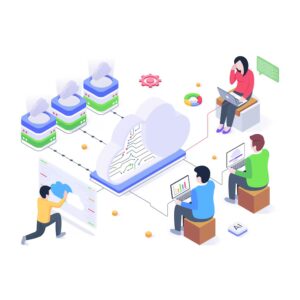Home Case Study Enhancing Data Analytics for Faster Diagnosis in Healthcare
Healthcare
Enhancing Data Analytics for Faster Diagnosis in Healthcare

Focus Areas
Clinical Data Analytics
Diagnostic Decision Support
Data Integration & Visualization

Business Problem
A multi-specialty healthcare provider experienced delays in diagnosis and inconsistent clinical decision-making due to fragmented data sources and limited use of advanced analytics. Physicians struggled to access timely insights from EHRs, imaging systems, and lab results. The organization sought to harness real-time analytics to support faster, more accurate diagnoses and improve patient outcomes.
Key challenges:
Data Fragmentation: Clinical, imaging, and lab data were spread across siloed systems with limited interoperability.
Manual Data Review: Physicians spent excessive time reviewing records, delaying treatment decisions.
Limited Predictive Capability: Lack of AI or ML tools to identify early warning signs or prioritize high-risk patients.
Poor Visualization Tools: Raw data lacked clinical context, making it difficult for clinicians to interpret quickly.
Scalability Issues: Legacy infrastructure struggled with high-volume data ingestion and processing.
The Approach
Curate collaborated with the provider to design an integrated analytics ecosystem powered by real-time data pipelines, AI-driven diagnostic models, and intuitive dashboards tailored to clinical workflows. The goal was to reduce diagnostic latency and enable data-driven decision-making at the point of care.
Key components of the solution:
Discovery and Requirements Gathering:
Clinical Workflow Mapping: Identified key diagnostic workflows across cardiology, oncology, and emergency medicine.
Data Source Audit: Evaluated EHRs, RIS/PACS, lab systems, and IoT devices to map available datasets.
Stakeholder Interviews: Worked with physicians, radiologists, and lab technicians to understand user needs.
Compliance Review: Ensured HIPAA-compliant data handling and patient privacy protections.
Solution Design and Implementation:
Unified Data Platform: Built a cloud-native data lake integrating EHR, imaging, and lab data using FHIR APIs and HL7 connectors.
Predictive Analytics Models: Developed ML models for early detection of sepsis, stroke risk, and abnormal lab trends.
Clinical Dashboards: Deployed real-time dashboards in Power BI and Looker with patient-specific diagnostic alerts.
Data Pipeline Automation: Implemented ETL workflows using Airflow and dbt for daily data refreshes and anomaly detection.
Natural Language Processing (NLP): Extracted key insights from unstructured clinical notes using spaCy and Amazon Comprehend Medical.
Process Optimization and Change Management:
Clinical Engagement: Co-designed dashboards with clinicians to ensure relevance and usability.
Training and Adoption: Delivered targeted training sessions to boost adoption and integrate tools into daily routines.
Feedback Loops: Established continuous feedback mechanisms for improving model accuracy and UI/UX.
Governance: Created a data governance council to oversee model updates and ensure ethical use of analytics.
Business Outcomes
Faster Diagnosis and Treatment Initiation
Real-time insights allowed clinicians to identify high-risk cases more quickly and act on early warning signs.
Improved Clinical Decision Support
Predictive models and intuitive dashboards reduced diagnostic uncertainty and variability across departments.
Streamlined Data Access and Analysis
Unified views eliminated manual data hunting and empowered clinicians with actionable insights in minutes.
Higher Patient Satisfaction
Faster, data-informed diagnoses led to shorter wait times, fewer unnecessary tests, and more timely care.
Sample KPIs
Here’s a quick summary of the kinds of KPI’s and goals teams were working towards**:
| Metric | Before | After | Improvement |
|---|---|---|---|
| Average time to diagnosis | 6.5 hours | 2.2 hours | 66% reduction |
| Time spent retrieving clinical data | 45 min/day | 10 min/day | 78% reduction |
| Sepsis early detection rate | 56% | 87% | 31% |
| Diagnostic error rate | 12% | 5% | 90% reduction |
| Clinician satisfaction with tools | 42% | 89% | 112% Improvement |
Customer Value
Accelerated Clinical Decision-Making
Enabled timely interventions, reducing complications and hospital stays.
Data-Driven Precision Care
Supported personalized treatment by highlighting key diagnostic patterns.
Sample Skills of Resources
Clinical Data Scientists: Developed and validated machine learning models for diagnosis support.
Data Engineers: Built robust, scalable pipelines for integrating and processing healthcare data.
UX/UI Designers: Created clinician-friendly dashboards aligned with workflows.
NLP Engineers: Extracted structured insights from clinical text and notes.
Healthcare Analysts: Mapped and measured clinical KPIs and model effectiveness.
Tools & Technologies
Data Integration: HL7, FHIR, Apache NiFi
Analytics & Visualization: Power BI, Looker, Tableau
Machine Learning: Python, scikit-learn, TensorFlow, Amazon SageMaker
NLP & Text Analytics: spaCy, Comprehend Medical, Spark NLP
ETL & Orchestration: dbt, Apache Airflow, Snowflake
Compliance & Security: Azure Key Vault, HIPAA Guardrails, OneTrust

Conclusion
By enhancing data analytics capabilities, Curate enabled the healthcare provider to deliver faster, more accurate diagnoses, improving patient outcomes and operational performance. The initiative successfully bridged data silos, brought predictive insights into clinical workflows, and laid the foundation for AI-enabled precision healthcare.
All Case Studies
View recent studies below or our entire library of work

Enhancing Kubernetes Cluster Monitoring with Custom Visualization Tools
TECHNOLOGY & SOFTWARE Enhancing Kubernetes Cluster Monitoring with Custom Visualization Tools Focus Areas Kubernetes Monitoring Custom Dashboards Observability and Alerting Business Problem A rapidly growing

Curate Supports Healthcare Company in Building a Dynamic Consumer Data Application
Healthcare case study Curate supports healthcare company in building a dynamic consumer data application How a leading national healthcare company consolidated disparate consumer engagement data

Enhancing Kubernetes Scalability and Security for a SaaS Company
TECHNOLOGY & SOFTWARE Enhancing Kubernetes Scalability and Security for a SaaS Company Focus Areas Kubernetes Orchestration Scalability Engineering Cloud-Native Security Business Problem A fast-growing SaaS

Deployment Efficiency for a SaaS Company Through CI/CD Automation
Technology & Software Deployment Efficiency for a SaaS Company Through CI/CD Automation Focus Areas CI/CD Pipeline Automation Deployment Velocity DevOps Transformation Business Problem A SaaS